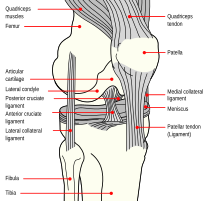User:Mr. Ibrahem/Anterior cruciate ligament injury
| Anterior cruciate ligament injury | |
|---|---|
 | |
| Diagram of the right knee | |
| Specialty | Orthopedics |
| Symptoms | A "pop" with pain, knee instability, swelling of knee[1] |
| Causes | Non-contact injury, contact injury[2] |
| Risk factors | Athletes, females[1] |
| Diagnostic method | Physical exam, MRI[1] |
| Prevention | Neuromuscular training,[3] core strengthening[4] |
| Treatment | Braces, physical therapy, surgery[1] |
| Frequency | c. 200,000 per year (US)[2] |
Anterior cruciate ligament injury is when the anterior cruciate ligament (ACL) is either stretched, partially torn, or completely torn.[1] The most common injury is a complete tear.[1] Symptoms include pain, a popping sound during injury, instability of the knee, and joint swelling.[1] Swelling generally appears within a couple of hours.[2] In approximately 50% of cases, other structures of the knee such as surrounding ligaments, cartilage, or meniscus are damaged.[1]
The underlying mechanism often involves a rapid change in direction, sudden stop, landing after a jump, or direct contact to the knee.[1] It is more common in athletes, particularly those who participate in alpine skiing, football (soccer), American football, or basketball.[1][5] Diagnosis is typically made by physical examination and is sometimes supported by magnetic resonance imaging (MRI).[1] Physical examination will often show tenderness around the knee joint, reduced range of motion of the knee, and increased looseness of the joint.[6]
Prevention is by neuromuscular training and core strengthening.[3][4] Treatment recommendations depend on desired level of activity.[1] In those with low levels of future activity, nonsurgical management including bracing and physiotherapy may be sufficient.[1] In those with high activity levels, surgical repair via arthroscopic anterior cruciate ligament reconstruction is often recommended.[1] This involves replacement with a tendon taken from another area of the body or from a cadaver.[6] Following surgery rehabilitation involves slowly expanding the range of motion of the joint, and strengthening the muscles around the knee.[1] Surgery, if recommended, is generally not performed until the initial inflammation from the injury has resolved.[1]
About 200,000 people are affected per year in the United States.[2] In some sports, females have a higher risk of ACL injury, while in others, both sexes are equally affected.[5][7] While adults with a complete tear have a higher rate of knee osteoarthritis, treatment strategy does not appear to change this risk.[8]
References[edit]
- ^ a b c d e f g h i j k l m n o p "Anterior Cruciate Ligament (ACL) Injuries-OrthoInfo - AAOS". orthoinfo.aaos.org. March 2014. Archived from the original on 5 July 2017. Retrieved 30 June 2017.
- ^ a b c d "ACL Injury: Does It Require Surgery?-OrthoInfo - AAOS". orthoinfo.aaos.org. September 2009. Archived from the original on 22 June 2017. Retrieved 30 June 2017.
- ^ a b Hewett TE, Ford KR, Myer GD (March 2006). "Anterior cruciate ligament injuries in female athletes: Part 2, a meta-analysis of neuromuscular interventions aimed at injury prevention". The American Journal of Sports Medicine. 34 (3): 490–8. doi:10.1177/0363546505282619. PMID 16382007.
- ^ a b Sugimoto D, Myer GD, Foss KD, Hewett TE (March 2015). "Specific exercise effects of preventive neuromuscular training intervention on anterior cruciate ligament injury risk reduction in young females: meta-analysis and subgroup analysis". British Journal of Sports Medicine. 49 (5): 282–9. doi:10.1136/bjsports-2014-093461. PMID 25452612.
- ^ a b Prodromos CC, Han Y, Rogowski J, Joyce B, Shi K (December 2007). "A meta-analysis of the incidence of anterior cruciate ligament tears as a function of gender, sport, and a knee injury-reduction regimen". Arthroscopy. 23 (12): 1320–25. doi:10.1016/j.arthro.2007.07.003. PMID 18063176.
- ^ a b "ACL Injury: Does It Require Surgery? - OrthoInfo - AAOS". Archived from the original on 2019-03-22. Retrieved 2018-03-22.
- ^ Montalvo, Alicia M; Schneider, Daniel K; Yut, Laura; Webster, Kate E; Beynnon, Bruce; Kocher, Mininder S; Myer, Gregory D (August 2019). "'What's my risk of sustaining an ACL injury while playing sports?' A systematic review with meta-analysis". British Journal of Sports Medicine. 53 (16): 1003–1012. doi:10.1136/bjsports-2016-096274. PMC 6561829. PMID 29514822.
- ^ Monk, A Paul; Davies, Loretta J; Hopewell, Sally; Harris, Kristina; Beard, David J; Price, Andrew J (3 April 2016). "Surgical versus conservative interventions for treating anterior cruciate ligament injuries". Cochrane Database of Systematic Reviews. 4: CD011166. doi:10.1002/14651858.CD011166.pub2. PMC 6464826. PMID 27039329.
